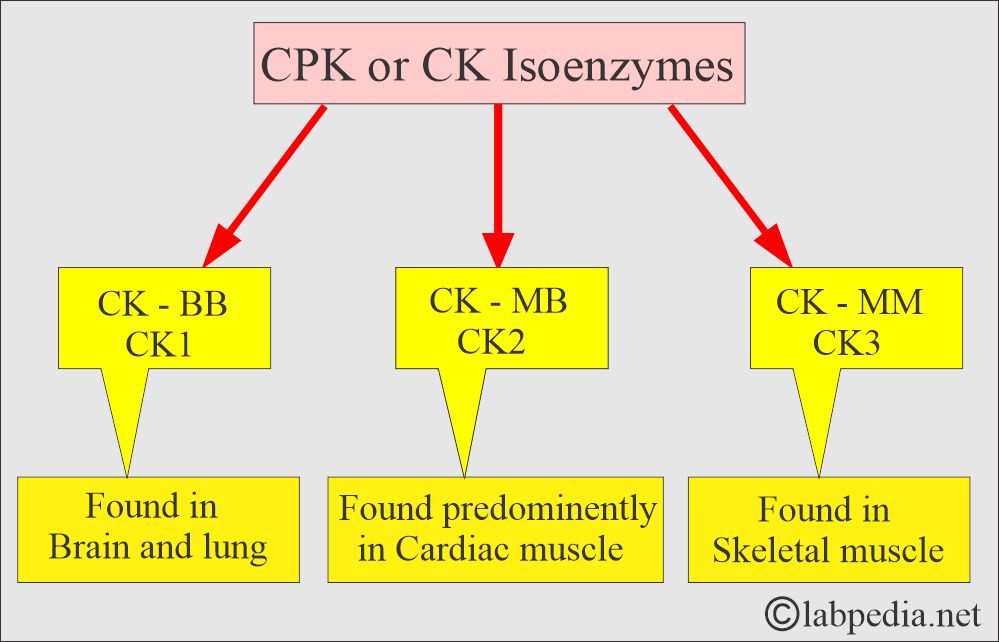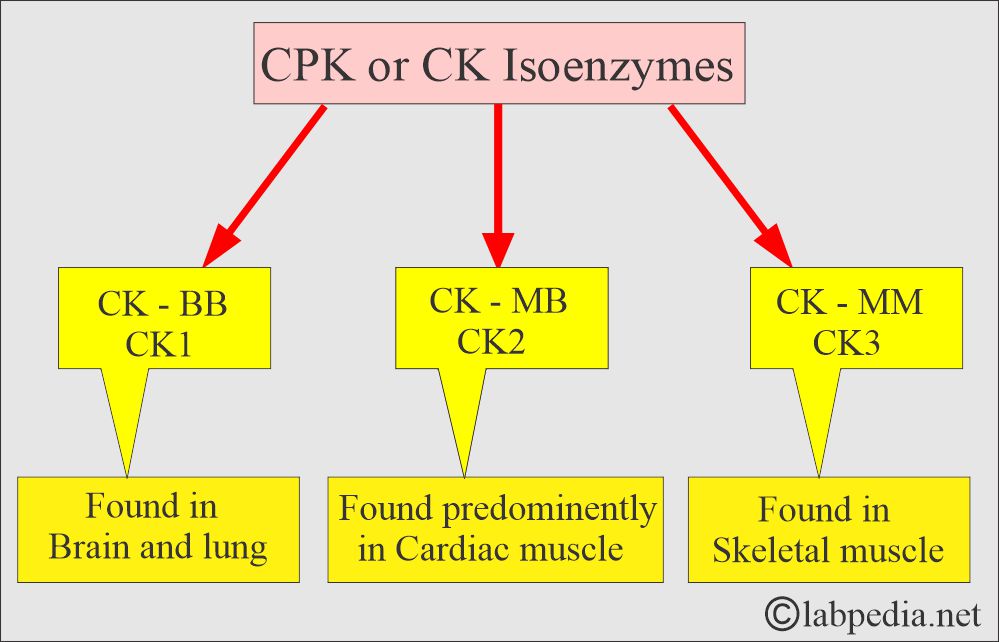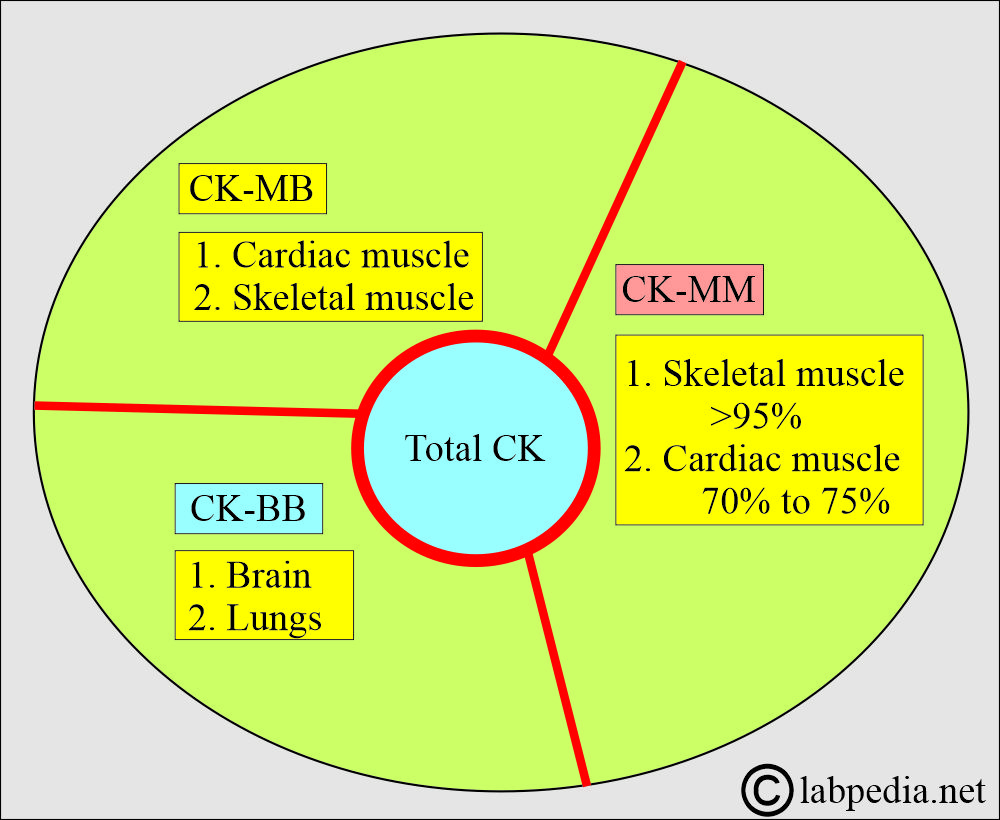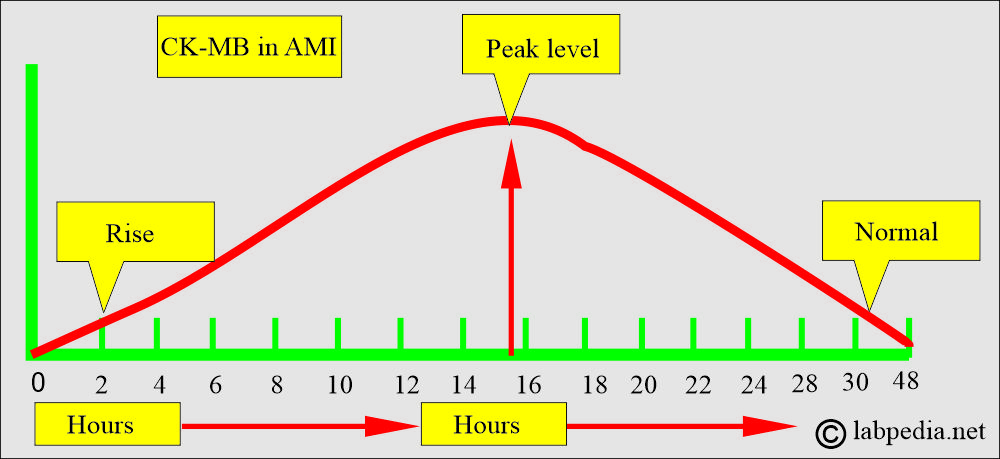Creatine kinase (CK), Creatine phosphokinase (CPK)
Creatine kinase (CK), Creatine Phosphokinase (CPK)
What sample is needed for Creatine kinase (CK)?
- It is done on serum (clotted blood 3 to 5 ml).
- The plasma may also be used.
- The sample is stable for 4 to 8 hours at room temperature.
- 1 to 2 days stable at 4 °C. (in another reference, the stability at 4 °C for 8 to 12 hours).
- One month stable at -20 °C.
- CK-MB level in case of AMI:
- In the case of AMI, get multiple samples of CK-MB at 6, 12, 18, and 24 hours.
- Some people recommend 4 samples, one immediately, then at 8, 16, and 24 hours.
- Some recommend 3 samples: immediately, 12 hours, and 24 hours.
What are the precautions for Creatine kinase (CK)?
- Avoid excessive physical therapy.
- There is no need for special preparation of the patient.
- Avoid the hemolyzed sample.
- Citrate and fluoride inhibit CK activity.
- Protect from light.
- Store in airtight tubes.
- Please do not take the sample immediately after the I/M injection. Either wait for at least one hour or take the sample before the injection.
- I/M raises the CK level.
- Trauma to the muscles makes the result unreliable for a few days.
What are the Indications for Creatine kinase (CK)?
- To find cardiac muscular injury (myocardial infarction).
- To support the possibility of neurologic or skeletal muscle diseases (Muscular dystrophy).
- This test is specific for muscular and cardiac muscle injury.
- CK-MB isoenzyme levels help quantify the degree of myocardial infarction and the timing of the onset of infarction.
- This enzyme is also used to determine the effectiveness of thrombolytic therapy used for myocardial infarction.
How will you discuss the pathophysiology of Creatine kinase (CK)?
- CPK (creatine phosphate) is the incorrect name, and actually, this is Creatine kinase.
- CK is also known as Creatine phosphokinase (CPK).
- CK gives a reversible phosphorylation reaction.
- Creatine Kinase (CK) is found predominantly in the heart muscles, Skeletal muscles, and brain.
- Concentration in the brain is low.
- It is elevated in 90% to 93% of patients with acute myocardial infarction (AMI).
- In AMI, it behaves like AST (SGOT).
- This is also elevated in myocarditis and some patients with tachyarrhythmias, mostly ventricular type, without any known reason.
- In the case of acute liver cell injury, where AST (SGOT) is raised, CK is normal.
- CK activity in the serum depends upon various physiologic variants, such as muscle mass.
- It is lower in females in comparison to males.
- Depends on the ethnic group, with more black American females than white males.
What are the causes of raised Creatine kinase (CK) levels?
- If the injury is transient, the peak level is 18 hours and then returns to normal in 2 to 3 days.
- CK values are usually raised in muscular dystrophy, muscular trauma, and myositis after surgery, postpartum, and after exercise (moderate to severe).
- This is also raised in delirium, convulsions, and tremens.
- CK level in alcoholics:
- CK level is abnormal after 24 to 48 hours in most persons after heavy drinking of alcohol and in patients with delirium and tremens. But CK level is normal in chronic alcoholics.
- CK level is normal in chronic alcoholics.
- CK level is usually raised after the I/M injections.
- CK level is raised in cases of meningitis, encephalitis, uremic coma, hepatic coma, cerebrovascular accidents, and epilepsy (seizures of epilepsy).
- CK is raised in 19% to 47% of uremia cases.
- CK is raised in about 80% of cases of hypothyroidism.
- CK is also raised in severe hypokalemia due to changes induced in the skeletal muscles.
What are the Isoenzymes of Creatine Kinase (CK, CPK)?
CK-BB = CK 1
- This is the fast-moving component.
- This is found mainly in the Brain, and a lesser amount is found in the urinary bladder, stomach, and prostate.
- These enzymes are present in the cells’ cytosol and myofibrillar structure.
CK-MB = CK 2
- This is found in cardiac and skeletal muscles.
- The cardiac muscle has 30%, and the skeletal muscle has 1% MB.
CK-MM = CK 3
- This is found in the Skeletal and cardiac muscles.
- Skeletal muscle is 99% MM, and cardiac muscle is 70%.
- It is raised in the muscular injury.
- The CK-MM isoenzyme constitutes almost all of the total circulatory CK in a healthy person.
- CK-MM depends on the muscle mass; large muscular people may have a high normal range.
CK-MB
How will you define CK-MB?
- It is raised in myocardial infarction.
- It does not arise in the case of angina, congestive heart failure, or pulmonary embolism.
- The mild rise may be seen in unstable angina, indicating a risk for occlusive attack.
What are the causes of raised CK-MB?
- There may be a rise in shock, myopathies, malignant hyperthermia, or myocarditis.
- A small amount of CK-MB is present in the skeletal muscles, so there may be a mild rise in the injury to skeletal muscles.
- CK-MB level does not rise in angina, pulmonary embolism, or congestive heart failure.
- CK-MB is advised that 12 and 24 hours of admission reflect the myocardial infarction’s timing, quantity, and resolution.
What is the pattern of CK and CK-MB in AMI?
| Enzyme | Starts to rise in hours | Peak level/hours | Returns to normal/days |
|
|
|
|
|
|
|
|
What is the clinical significance of creatine kinase (CK) or Creatine phosphokinase (CPK)?
Muscular diseases:
- This is significantly elevated in muscular disorders, especially muscular dystrophy (Duchenne type), where it is 50 times the normal upper limit.
- This may be raised before the clinical disease is apparent.
- CK activity decreases with the increasing age of the patient.
- Patients with Duchenne disease, female carriers, aged 50 to 80, have 3 to 6 times higher CK levels in their blood.
- A markedly raised level of CK is seen in viral myositis, polymyositis, and muscle diseases.
- The level is normal in neurogenic muscular diseases like myasthenia gravis, multiple sclerosis, poliomyelitis, and Parkinson’s disease.
- CK-MM is 7 to 12 times higher than the normal value.
Myocardial infarction:
- CK-MB is normal initially in Myocardial infarction (MI) and begins to rise:
- 2 to 4 hours after the infarction.
- The peak is between 12 to 24 hours.
- Return to normal within 48 hours.
- The level is 10 to 25 times the normal value.
- Nowadays, a more specific test than CK- MB is Troponin-T.
- CK-MB is a diagnostic of MI.
- If there is a negative CK-MB for >48 hours, it is clear that the patient had no MI attack.
- The CK-MB level is helpful in quantifying the level of muscle damage in MI.
- CK-MB/total CK ratio:
- It improves the specificity of CK-MB for myocardial infarction.
- If it is >5%, it suggests a cardiac source (cardiac muscle damage).
Liver diseases:
- As the liver has a negligible amount of CK, there is no marked increase in CK in liver diseases.
- In cirrhosis, CK is normal.
Central nervous system diseases:
- There is an increase in the CK level in cerebrovascular diseases and cerebral ischemia.
- There is a noticeable increase in CK-3 (CK-MM).
- There is no CK-1 (CK-BB) increase.
Thyroid diseases:
- In hypothyroid 60% of the cases (in another reference, 80%), there is 5 to 50 times more elevation than the normal range.
- In hyperthyroidism, the CK activity is low to the lower level of normal.
- The main isoenzyme is CK-3 (CK-MM).
What are the drawbacks of the Creatine kinase (CK) level?
- As CK depends upon muscle mass, its level will be low in a person with less muscle mass.
- CK level after AMI is short when the CK level is raised.
- False raised level after I/M injection.
What is Normal Creatine Kinase (CK or CPK)?
Source 1
- 0 to 250 U/L
- Adult male = 55 to 170 units/L/L
- Female = 30 to 135 units/L/L
- Above 90 years
- Male = 21 to 203 U/L
- Female = 22 to 99 U/L
- Newborn = 68 to 580 U/L (2 to 3 times the adult value).
- Isoenzymes:
- CK-MM (CK-3) =94% to 100 %
- CK-MB (CK-2)= 0% to 6 %
- CK-BB (CK-1) = 0 %
Source 2
| Age | Male U/L | Female U/L |
| At 37 °C | ||
| 20 to 60 years | 52 to 200 | 35 to 165 |
| Adult | 38 to 174 | 26 to 140 |
| >90 years | 21 to 203 | 22 to 99 |
| AT 30 °C | ||
| 20 to 59 years | 25 to 80 | 20 to 75 |
| 60 to 69 years | 20 to 110 | 61 to 81 |
| 70 to 90 | 22 to 90 | 19 to 76 |
| Adult | 15 to 105 | 10 to 80 |
| At 25 °C | ||
| Adult | 10 to 65 | 7 to 55 |
- To convert to SI unit x 0.017 = µKat/L
What are the causes of a raised level of total Creatine kinase (CK)?
- Increased CK/CPK seen in:
- Acute myocardial infarction.
- Severe myocarditis.
- After open-heart surgery.
- Acute cerebrovascular accidents.
- Progressive muscular dystrophy.
- Dermatomyositis and Polymyositis.
- Electric shock.
- Malignant hyperthermia.
- Reye’s syndrome.
- Last week of pregnancy and during childbirth.
- Hypothyroidism.
- Acute psychosis.
- Neoplasm of the prostate, GI Tract, and Urinary bladder.
- The only raised level of CK is seen in the injury of the heart muscles, skeletal muscles, and brain.
- CK-MM is raised in muscular injuries.
- CK-MB is raised in myocardial infarction due to damage.
- CK-BB is raised in brain injury.
What are the causes of a raised level of CK-MB?
- CK-MB is a specific test for the assessment of myocardial injury.
- Acute myocardial infarction.
- Cardiac surgery (e.g., an aneurysm ).
- Cardiac defibrillation.
- Myocarditis.
- cardiac ischemia.
- ventricular arrhythmias
What are the causes of a raised level of CK-MM?
- Muscular dystrophy.
- Rhabdomyolysis.
- Myositis.
- Recent injury.
- Intramuscular injection.
- Trauma and crushing injuries.
- Hypothyroidism.
- Shock.
What are the causes of a raised level of CK-BB?
- Brain Injury.
- Brain cancers.
- Cerebrovascular accidents.
- Subarachnoid hemorrhage.
- Shock.
- Seizure.
- Adenocarcinoma is prevalent, especially in the lung and breast.
- Pulmonary infarction.
- Normal values are found in myasthenia gravis and multiple sclerosis.
What is the difference between CK and CPK?
- CK (creatine kinase), also known as CPK (creatine phosphokinase).
- This enzyme catalyzes the phosphorylation of creatine.
- Creatine kinase is a dimer that exists as isoenzymes with great activity in the heart muscle (CK-MB), muscles (CK-MM), and brain tissue (CK-BB).
Questions and answers:
Question 1: What are the types of CK (Creatine phosphokinase)?
Question 2: What is the significance of CK-MB in AMI?






